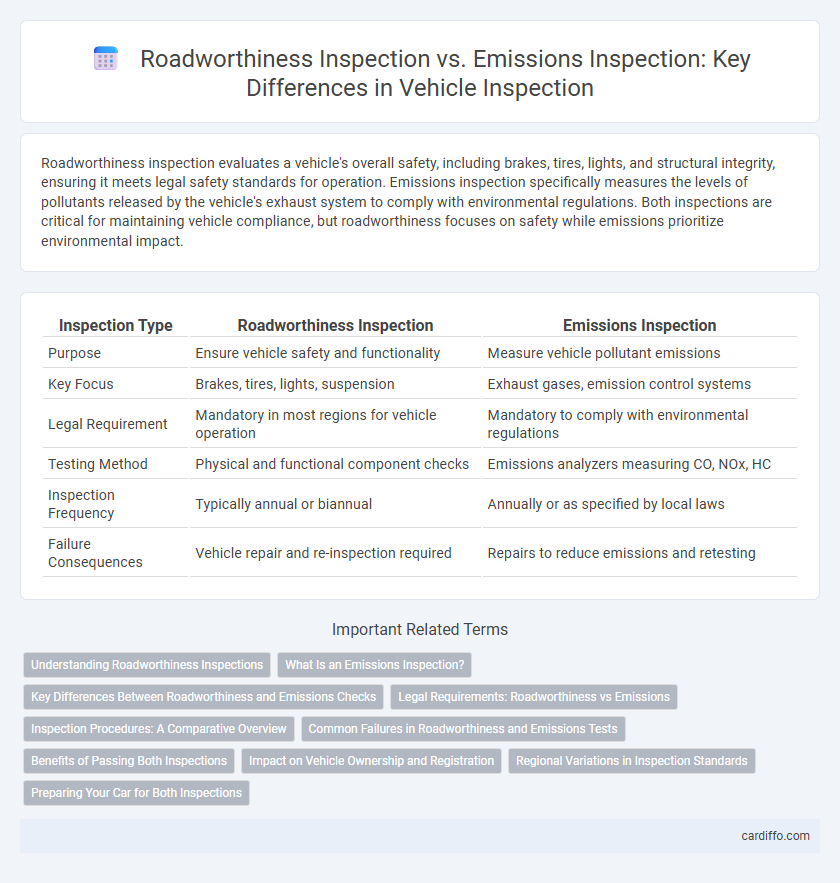Roadworthiness inspection evaluates a vehicle's overall safety, including brakes, tires, lights, and structural integrity, ensuring it meets legal safety standards for operation. Emissions inspection specifically measures the levels of pollutants released by the vehicle's exhaust system to comply with environmental regulations. Both inspections are critical for maintaining vehicle compliance, but roadworthiness focuses on safety while emissions prioritize environmental impact.
Table of Comparison
| Inspection Type | Roadworthiness Inspection | Emissions Inspection |
|---|---|---|
| Purpose | Ensure vehicle safety and functionality | Measure vehicle pollutant emissions |
| Key Focus | Brakes, tires, lights, suspension | Exhaust gases, emission control systems |
| Legal Requirement | Mandatory in most regions for vehicle operation | Mandatory to comply with environmental regulations |
| Testing Method | Physical and functional component checks | Emissions analyzers measuring CO, NOx, HC |
| Inspection Frequency | Typically annual or biannual | Annually or as specified by local laws |
| Failure Consequences | Vehicle repair and re-inspection required | Repairs to reduce emissions and retesting |
Understanding Roadworthiness Inspections
Roadworthiness inspections assess a vehicle's overall safety and mechanical condition, ensuring key systems such as brakes, suspension, and lights meet regulatory standards. These inspections are critical for preventing accidents by identifying defects that may impair vehicle control or stability. Unlike emissions inspections that focus solely on environmental pollutants, roadworthiness inspections provide a comprehensive evaluation of a vehicle's operational integrity and compliance with safety laws.
What Is an Emissions Inspection?
An emissions inspection measures the level of pollutants released from a vehicle's exhaust to ensure compliance with environmental standards set by regulatory agencies such as the Environmental Protection Agency (EPA). This inspection analyzes gases like carbon monoxide, hydrocarbons, and nitrogen oxides, which contribute to air pollution and smog. Unlike a roadworthiness inspection that assesses vehicle safety components, emissions inspections focus exclusively on reducing harmful emissions to improve air quality and public health.
Key Differences Between Roadworthiness and Emissions Checks
Roadworthiness inspections primarily assess the overall safety and mechanical condition of a vehicle, including brakes, tires, lights, and steering. Emissions inspections specifically measure the vehicle's exhaust output to ensure compliance with environmental standards and reduce air pollution. Roadworthiness checks focus on mechanical integrity, while emissions checks target environmental impact through pollutant limits.
Legal Requirements: Roadworthiness vs Emissions
Roadworthiness inspections ensure vehicles meet safety standards by checking critical components such as brakes, tires, lights, and suspension, complying with legal requirements designed to prevent accidents. Emissions inspections focus specifically on measuring pollutants released from the vehicle's exhaust system, ensuring adherence to environmental regulations that limit harmful emissions like CO2, NOx, and particulate matter. Legal requirements for roadworthiness and emissions inspections vary by jurisdiction but collectively enforce vehicle safety and environmental protection standards.
Inspection Procedures: A Comparative Overview
Roadworthiness inspection involves a comprehensive evaluation of a vehicle's mechanical and safety systems, including brakes, tires, lights, and suspension, to ensure compliance with safety standards. Emissions inspection specifically measures exhaust pollutants such as carbon monoxide (CO), hydrocarbons (HC), and nitrogen oxides (NOx) using specialized analyzers to verify adherence to environmental regulations. Both inspections require certified technicians and standardized testing protocols, but roadworthiness focuses on vehicle safety performance while emissions inspection targets environmental impact mitigation.
Common Failures in Roadworthiness and Emissions Tests
Common failures in roadworthiness inspections often include defective brakes, worn tires, and malfunctioning lights, which directly impact vehicle safety and compliance. Emissions inspections frequently detect issues like faulty oxygen sensors, leaking exhaust systems, and degraded catalytic converters, leading to excessive pollutant output. Both inspections are critical for ensuring vehicles meet safety and environmental standards, with repairs targeted according to specific diagnostic results.
Benefits of Passing Both Inspections
Passing both Roadworthiness Inspection and Emissions Inspection ensures optimal vehicle safety and environmental compliance, reducing the risk of accidents and harmful pollution. Vehicles meeting these standards maintain better performance, potentially lowering maintenance costs and improving fuel efficiency. Compliance with these inspections also prevents legal penalties and enhances overall public health by minimizing hazardous emissions and promoting safer roads.
Impact on Vehicle Ownership and Registration
Roadworthiness inspections ensure a vehicle meets safety standards, directly affecting its eligibility for registration renewal and legal road use, while emissions inspections target environmental compliance, influencing the vehicle's environmental certification and potential restrictions in low-emission zones. Failure in roadworthiness tests can lead to immediate suspension of vehicle registration, impacting ownership status and requiring repairs before re-inspection. Emissions test failures may result in fines, additional testing, or mandated emission control upgrades, creating ongoing financial and regulatory implications for vehicle owners.
Regional Variations in Inspection Standards
Roadworthiness inspection standards vary significantly across regions, with some areas emphasizing mechanical safety and structural integrity while others integrate more stringent emissions testing protocols to meet environmental regulations. Regions with high pollution levels often enforce rigorous emissions inspections aligned with air quality goals, contrasting with areas prioritizing vehicle safety through comprehensive roadworthiness checks. Understanding these regional differences is crucial for maintaining compliance with local inspection requirements and ensuring both vehicle safety and environmental protection.
Preparing Your Car for Both Inspections
Preparing your car for both roadworthiness and emissions inspections requires thorough maintenance of critical systems. Ensure brakes, tires, lights, and suspension components meet safety standards, while checking engine performance and exhaust systems to reduce harmful emissions. Regular oil changes, air filter replacements, and addressing check engine light issues enhance inspection success for both roadworthiness and emissions compliance.
Roadworthiness Inspection vs Emissions Inspection Infographic

 cardiffo.com
cardiffo.com